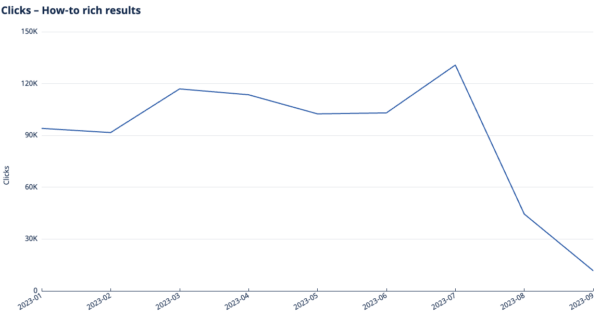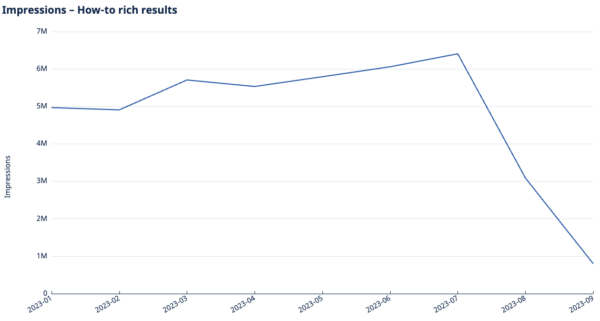On September 14, Google announced that they’ve officially removed How-To rich results on desktop and deprecated How-To rich results entirely as part of their efforts to simplify search. They will also be ‘dropping the How-to search appearance, rich result report, and support in the Rich results test in 30 days’. The How-To structured data feature guide is also no longer available on their site.
This past August, Google first removed How-To rich results on mobile. As a result, we saw a huge decline in clicks and impressions for How-To rich results across our customers. This updated announcement will undoubtedly remove all traffic and impressions from the rich result.


Why is this happening?
Prior to this change, content publishers would add HowTo Schema Markup to pages with instructional content that defined the steps needed to successfully complete a task. If appropriate, Google would then award the page with a How-To rich result that outlined the steps in the SERP.

However, we’ve often found How-To rich results to be somewhat controversial. On one hand, rich results were supposed to increase user engagement and drive click-through rates to a site. On the other hand, How-To rich results usually provided users with the answer directly on the SERP, resulting in a lower click-through rate. As such, How-To rich results were not as widely adopted as other rich results like product, review snippets and FAQ.
That said, How-To rich results still provided users with valuable information on the SERP and could help organizations improve their customer journey. So why is Google removing this rich result from the SERP?
In their announcement, Google mentioned that this was a continued effort on their end to ‘simplify search results’. This year, Google has made some significant changes to the SERP.
- They introduced Search Generative Experience (SGE) – their generative AI-powered search interface.
- They stopped awarding video rich results to pages that did not have a video as their main content.
- They stopped awarding FAQ rich results on both desktop and mobile for most websites and will only be showing FAQ rich results for well-known, authoritative government and health websites.
- They deprecated How-To rich results entirely from the SERP.
However, this begs the question: What does Google mean by simplifying search results?
Are they trying to declutter the search engine results page? They did reduce the visibility of video and FAQ rich results in the past few months, possibly because people were abusing them. However, the SERP is still littered with advertisements, making it tougher for users to identify the most appropriate result for their query.
Or could they be simplifying search results that SGE can also provide? As seen in SEO expert, Glenn Gabe’s tweet, the content from the same How-To was shown in SGE and in the first position in the SERP as a How-To rich result.
Ah, yes. But this is about the desktop version being removed. This is how it looked. See my listing below SGE (when HowTo was still there on desktop). 🙂 pic.twitter.com/S1nqtYukNa
— Glenn Gabe (@glenngabe) September 14, 2023
One of the glowing features of SGE is its ability to provide users with answers and additional relevant information that they might need. If you search up how to perform a task, SGE can provide you the steps to perform the task successfully and links to a few pages that also capture those steps.
If you search for the top Italian restaurants, SGE can provide you with a list of restaurants together with a map showing where they’re located in proximity to you, and links to aggregator sites that also have a list of top Italian restaurants in your city. These are just two of the many examples of how SGE creates helpful experiences based on the wealth of information on the web.
At its core, Google’s mission is to organize the world’s information and make it universally accessible and useful. Rich results were first introduced to provide users with more useful information in search, help them make better decisions and find answers. It was also a way for Google to incentivize website owners to add structured data to their sites to help search engines understand the content on a page.
But with SGE providing the information in a simplified way, more rich results could be rendered obsolete in the coming years. That said, this does not mean that you should abandon adding Schema Markup to your site.
What should you do next?
Schema Markup helps machines understand and contextualize the content and information on your website.
Even though you will no longer achieve a How-To rich result on your page, you should still add Schema Markup to your pages to futureproof your organization for search.
This is a paradigm shift that requires SEOs to think about the value of Schema Markup beyond rich results.
Over the past few years, search algorithms have shifted from lexical to semantic search. Instead of ranking pages based on keyword matching, search engines are ranking pages based on the relevance of the concepts and entities in the page’s content to the searcher’s query.
And how do you identify and define the entities on your website for search engines? You can define the entities on your website using Schema Markup.
By marking up the content on your site, you are helping search engines understand the concepts and entities on your website and providing them with contextual information about these entities. In return, they can better match your page to a query and ideally improve your ranking on search in the long run.
If you are interested in learning more about entities and semantic search, you can tune in to our recent webinar with Mike King or Schema Markup expert, Dave Ojeda’s latest interview on iPullRank’s Rankable podcast.
Generative AI search engines like SGE and the new Bing still face hallucination challenges resulting in inaccurate results. At Schema App, we’ve been advising our customers to think about the semantic value of Schema Markup.
Instead of implementing Schema Markup on a handful of pages for the sole purpose of achieving a rich result, you should implement Schema Markup across your site to define the entities and concepts on your site and link them to develop your very own marketing knowledge graph.
Knowledge graphs are a structured and organized information data layer that can help search engines to improve the accuracy of their answers and provide your organization with a control point to inform generative AI on your web content. Your marketing knowledge graph can also be reused for other AI initiatives.
As the SEO industry continues to see changes from Google and on search, organizations need to prepare to stay ahead of the competition. If you are looking to learn more about semantic Schema Markup, we can help.
Contact us to see how we can help your organization build a marketing knowledge graph and future proof your organization for AI search.
If you are a Schema App customer with concerns regarding the changes in rich results, please get in touch with your Customer Success Manager to see how we can support your organization through these changes.

